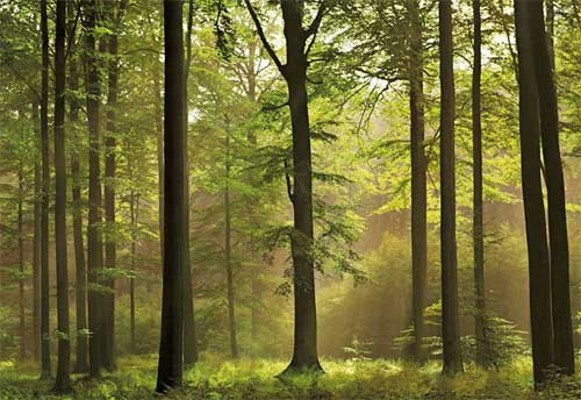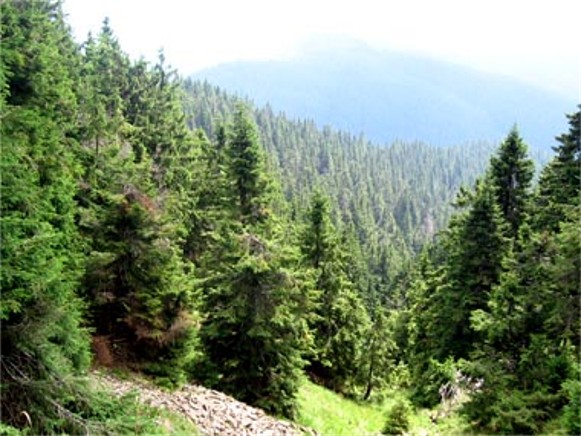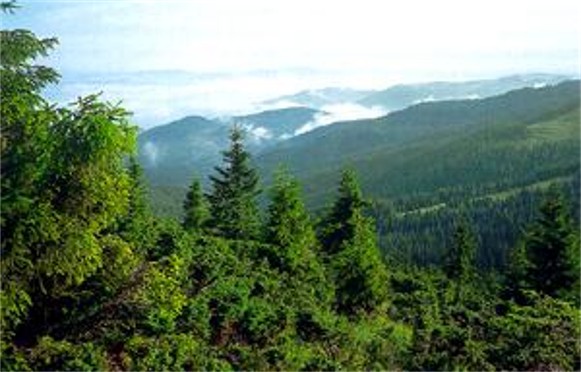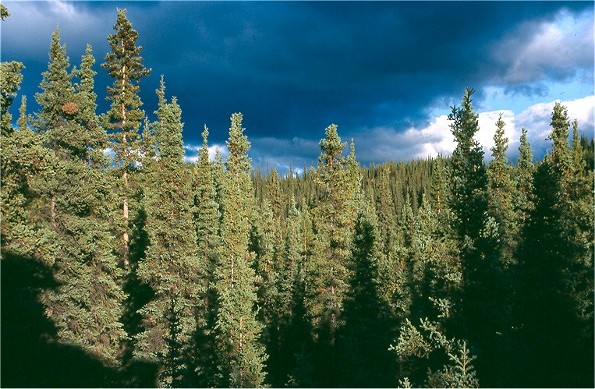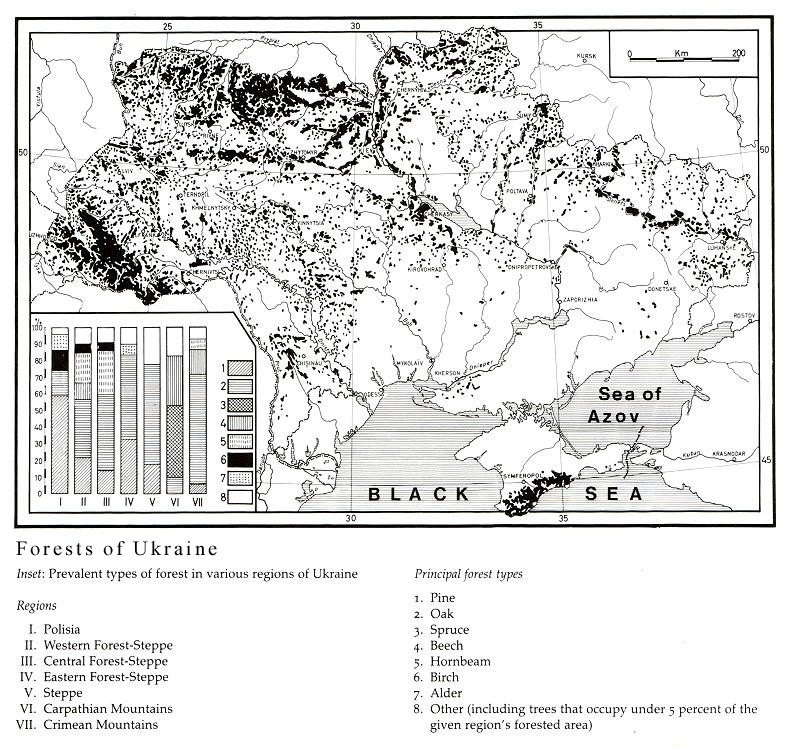Forest
Forest. (Map: Forests of Ukraine.) One of the basic types of vegetation groupings, consisting of trees and shrubs and covering an extensive area. Forests have an effect on climate; the hydrological regime of the soil and the environment; the retention of surface soils, particularly on steep slopes and sands; and the composition of flora and fauna. Forests also have an enormous economic and esthetic importance. In the past forests provided humans with protection from invaders and uninhabited space for settlement.
The degree of forestation and the variety of forest species in Ukraine are determined by Ukraine's geographical position between the humid region of Western Europe and the dry steppes of Asia. The forests in the western part of Ukraine have a Western European character; in the southern part small woods rather than forests are found. As Ukraine's climate, relief, soils, and water regime change from the west and north towards the east and south, large differences arise in the extent of forestation and the composition of the forests. The eastern and part of the southern limits of dispersal for such important tree species as the fir, spruce, beech, hornbeam, and ash dissect Ukraine.
In prehistoric times the following natural regions of Ukraine were almost completely covered with forest: the northern forest belt consisting of Polisia with the exception of the bogs, the mountains with the exception of the slopes above the forest line, Subcarpathia, the Sian Lowland, and Roztochia; one-quarter to one-half of the forest-steppe belt (mostly on the high right banks of rivers and on the watersheds); and the river valleys and ravines in the steppe belt. Altogether forests covered probably over one-third of Ukraine's territory. Eventually, human intervention halted the natural expansion of the forests in the forest-steppe belt. Settlement and farming led to a contraction of the forested area. From the 17th to the 19th century large tracts of forest were sacrificed to the lumber export trade (see Lumber industry) and to the fuel industry, particularly in central and eastern Ukraine, where in 1880–1913 alone the forest area in the nine Ukrainian gubernias fell from 4,858,000 to 3,861,000 ha. Deforestation was particularly rapid in Ukraine during the two world wars and in 1944–5, when the Soviets exploited the forests mercilessly, especially in the Carpathian Mountains (see Forest management). As a result, the forest area of Ukrainian ethnic territories has been reduced to about 13–14 percent of the total area and, of Ukraine, from 18 percent at the end of the 18th century to 15 percent in 1890 and 14 percent in 1968. At the same time the fund of valuable tree species has been depleted; for example, in the Carpathian Mountains the beech and fir have been replaced by the spruce, the cedar has almost disappeared, the yew is extinct, and the oak has become rare. Since the 1980s, particularly in the forest-steppe and steppe belts, the authorities have increased the planting of fast-growing species such as the poplar, willow, white acacia, and larch.
Today forests cover about 11 million ha of all Ukrainian territories. In 1978, the general forest area of the Ukrainian SSR was 9.7 million ha, of which 8.3 million were covered with trees. On the average 13.6 percent of Ukraine's territory is under forest. Fifty-two percent of the trees are deciduous and 48 percent are coniferous. The composition of the forests by tree species is given in Table 1. There are 15 coniferous species (12 tree and 3 bush varieties) and 74 deciduous species (59 tree and 15 bush varieties) in Ukraine. There is approximately 0.19 ha of forest per capita (2.4 in the former USSR).
The extent of forestation in each vegetation belt of Ukraine is given in Table 2. In Polisia the central part is most densely forested. The main tree species is the pine (about 60 percent), which is mixed with oak (15 percent) on the richer soils. Birch (12 percent) and aspen (10 percent), which are of low value and often occupy the tracts cleared of pine, are quite widespread.
In the forest-steppe belt the most densely forested areas are Roztochia, the Sian Lowland, and the Buh Depression. The forests here (beech, pine, oak, etc) are similar to the forests of Central Europe. In the forest-steppe belt itself oak is the most prevalent species (about half of the forest area); it is mixed with beech (only in western Podilia), hornbeam (mostly in Right-Bank Ukraine—26 percent of the forest area), ash, maple, and linden. Pines grow on the left-bank terraces of rivers, covering 30 percent of the forest area in Left-Bank Ukraine. In spite of extensive deforestation the remnants of large ancient forests have been preserved here and there, for example, the Chornyi Lis Forest near Znamianka, the Trostianets Forest in Sumy oblast, the Cherkasy Forest, consisting of pine, on the Dnipro River, the Lithuanian Forest on the Vorskla River, and the Donets Forest.
The forests of Subcarpathia and the Carpathian Mountains consist of beech in the southwest and spruce with an admixture of beech and fir elsewhere. In the forests of the Crimean Mountains and Caucasia the dominant trees are the oak and beech, with an admixture of hornbeam and maple. The Crimean pine also grows in the Crimea. On the southern slopes of the mountains subtropical forests can be found.
No substantial forests grow in the steppe belt. Here woods are found in ravines, wet forests in the wetlands, pine copses on the Oleshia Sands, and shelterbelts along the Donets River. The main species are the oak (60 percent), pine, hornbeam, white acacia, ash, maple, and elm.
Special preserves and reservations have been established in order to preserve the ancient forests in their original state.
BIBLIOGRAPHY
Vysotskii, G. Lesa Ukrainy, no 1 (Kyiv 1918)
Morozov, H. Nauka pro lis (Kyiv 1927)
Ivanyts’kyi, B. Lisy i lisove hospodarstvo na Ukraïni, 1–2. Pratsi Ukraïns’koho naukovoho instytutu, 27, 45 (Warsaw 1936, 1939)
Piasets’kyi, A. Pro pobuduvannia i biolochichnyi rozvytok riadu typiv ukraïns’koho lisu (Lviv 1942)
Lavrinenko, D.; Florovskii, A.; Kovalevskii, A. Tipy lesnykh kul’tur dlia Ukraïny (Kyiv 1956)
Povarnytsyn, V. Lisy Ukraïns’koho Polissia (Kyiv 1959)
Soldatov, A.; Tiukov, S.; Turkevych, M. Lisy Ukraïny (Kyiv 1960)
Pogrebniak, P. Obshchee lesovodstvo (Moscow 1968)
Gensiruk, S. Lesa Ukrainy (Moscow 1975)
V. Kubijovyč, B. Luchakovsky
